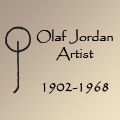
|

|
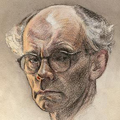
|
|
Introduction 1925-34 Travels in Europe 1935-38 In Yugoslavia 1939-45 War years 1945-68 In Sweden Contact © Olaf Jordan |
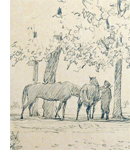 Decin/Tetschen in Bohemia was again the home of Olaf Jordan and his wife during the war, and two more children were born.
It was not until 1941 that Jordan was called to duty in the German army. He was transferred to a special staff of pictorial
artists and was attached to the 1st Cossack Cavalry Division as an army artist. These Cossack volunteers had allied
themselves with the Germans to fight for the autonomy they had lost under Soviet rule. Jordan followed them on the Balkans
for nearly three years recording their life in sketches and portraits. He was captured together with the Cossacks when they
surrendered to the British in Austria in May 1945.
Decin/Tetschen in Bohemia was again the home of Olaf Jordan and his wife during the war, and two more children were born.
It was not until 1941 that Jordan was called to duty in the German army. He was transferred to a special staff of pictorial
artists and was attached to the 1st Cossack Cavalry Division as an army artist. These Cossack volunteers had allied
themselves with the Germans to fight for the autonomy they had lost under Soviet rule. Jordan followed them on the Balkans
for nearly three years recording their life in sketches and portraits. He was captured together with the Cossacks when they
surrendered to the British in Austria in May 1945.
After the war an American officer found a hidden bunch of sketches and portraits signed Olaf Jordan. Together with works by other German army artists they were brought to the USA, where they were kept at the US Army Center of Military History in Washington D.C. It was not until some of his Cossack portraits had been published in a 1950 issue of Life Magazine that Jordan became aware of the fate of his wartime pictures. He was not allowed to get them back, however, as they were regarded as American war booty. They remained in the Pentagon archives. 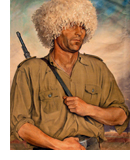
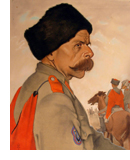 After many years American art professor Dr. Bruce Carter came across Jordan´s works and was struck by the artistic and human
qualities of these images of Cossacks and prisoners of war. He arranged an exhibition in Pittsburgh, Pennsylvania,
in 1975, “The Captured War Art of Olaf Jordan”, so ‘far superior to the usual glorified propaganda art ‘ (The Pittsburgh Press).
The immediate and overwhelming public response did not reach Jordan, however, as he had died seven years before.
After many years American art professor Dr. Bruce Carter came across Jordan´s works and was struck by the artistic and human
qualities of these images of Cossacks and prisoners of war. He arranged an exhibition in Pittsburgh, Pennsylvania,
in 1975, “The Captured War Art of Olaf Jordan”, so ‘far superior to the usual glorified propaganda art ‘ (The Pittsburgh Press).
The immediate and overwhelming public response did not reach Jordan, however, as he had died seven years before.
Half a century after WW II the works of the German war artists were returned to Germany, and Olaf Jordan´s works are now kept at the German Historical Museum in Berlin, in their “German War Art Collection”’. |
|